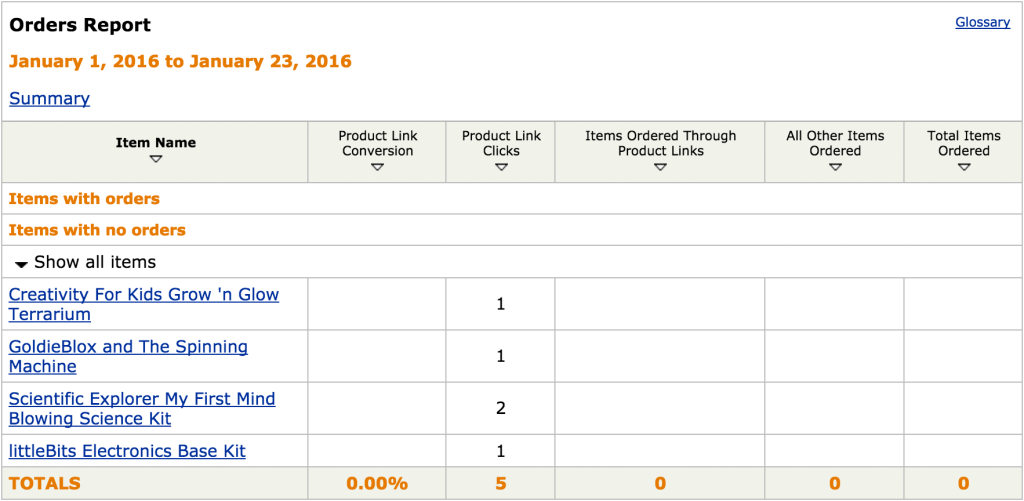
Welcome to the final Monday post of the month, and the conclusion of our affiliate blogging experiment. I know this has been a bit of an unusual direction for Otaku Journalist, and thank you so much for sticking with me this whole time. One of my most important goals with this blog is to help people make a living writing about the things they are most passionate about, and for me this is one of the most independent ways to pursue that goal.
Anyway, let’s take a look at the numbers! Last week I hypothesized that STEM Toys For Girls would not make any money yet and…

Unfortunately, I was right. Looking at the orders report, you can see that while there were 13 different clicks on the site (and 5 on products), nobody bought anything.
The way it works is that when somebody visits your affiliate site and clicks on a product link, Amazon assigns a cookie to their Amazon account for 24 hours. If they buy anything within the following 24 hours, you make a commission on it. In this case, out of the very few people who visited the site, nobody bought anything within that time period.
Here’s an example of a healthier conversion rate, taken from another of my affiliate sites:

Notice that even with 9,000 clicks, my conversion rate is still just 4 percent here. Not everybody who visits your site is in the mood to shop, so obviously, your chances of making money this way significantly increase the more clicks and traffic you get.

In the Orders Report, I can check out what people are clicking on. With a data sample this small, it’s not really worth analyzing which products are resonating with people.
In the interest of full disclosure, not a single affiliate site I have ever created has made money in its first month. That’s probably because I don’t use any tactics to escalate traffic early on. Instead, I slowly add more and more content to my blog until it becomes a top search result.
That’s why I so strongly emphasized testing your topic in Google Keyword Planner. You want to make sure it’s something low competition enough that your site will be able to appear on the first page of search results for that topic early on.
There are a lot of below-board techniques for speeding up your income rate, none of which I recommend. Instead, here’s what I’ll be doing to increase traffic to my site, and therefore encourage more clicks to my affiliate links:
- Increase its amount of valuable content. You may have noticed that there are only three pages on this site, same as last week. (I got busy, OK?) A site that small doesn’t exactly encourage you to browse around for a while. If I want to increase my chance of showing up in searches—and retaining visitors who do find it—I should add more posts. And of course, these posts should be helpful and informative, not spammy.
- Share my site in relevant spaces. I could post in forums for parents and educators interested in STEM toys. I could leave comments on other STEM related blogs, and include a link to my own site when it’s helpful. While we often think of it as annoying to share our blogs with strangers, there are places where people would not only not be irritated, but actually enjoy the fact that we shared.
- Live my life. There’s always a chance that, even after putting in a lot more work, this blog won’t be a moneymaker. So I’m not going to obsess over it. In order to make sure the time I put in is productive, I won’t check my Amazon Affiliate stats daily, only on the days after I post an update. The point of so-called passive income is that you put in a lot of work up front and then put it on the backburner, so eventually I’ll do that.
Right now, I’m putting the finishing touches on the affiliate marketing guide I mentioned at the beginning of this series. When it’s for sale in February, my readers will be the first to know.
Thanks for reading, and I hope you found this short blog-along helpful!
Previously:
How to design and launch your niche affiliate blog
Choosing keywords and content types for your affiliate blog
Finding a topic for your niche blog
Photo credit: Matthias Ripp
